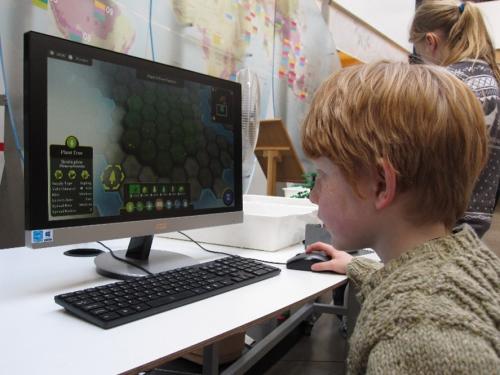The public are being asked to report sightings of 22 tree pests and diseases and newly emerging threats. By working with computer game designers to create a freely available online forest management game we can enable players pit their wits against, and learn more about, pests and diseases.
The virtual forest simulator – CALEDON – is a survival strategy game that aims to develop understanding of plant health issues as they relate to forestry. By using the increasingly popular gaming medium, it is hoped that younger people will become interested in forestry and plant health as potential future careers.

Stage
Directory of Expertise
Purpose
Forest cover is low in Scotland compared to other European countries, accounting for only 19 per cent of the total land area. The Scottish government has targets to increase tree cover to diversify rural economies, create wildlife habitat and address climate change. At the same time, a growing number of threats to tree health and the need for more plant health professionals, present major hurdles in achieving ambitious targets for forest expansion and renewal.
CALEDON, inspired by the popularity of virtual worlds in gaming, is first and foremost intended to be a fun gaming experience. Playing as the forest manager means that success is determined by decisions on expanding tree cover and harvesting timber and how effectively pest and disease outbreaks are managed. Finding the sweet spot where trees thrive, income is being generated and wildlife populations are in balance requires knowledge learned through experience of play and by consulting the games built-in encyclopedia.
An important aspect of the game is that trees can adapt through natural selection. In nature trees adapt to reach a stable balance with pests and diseases. However, currently natural processes aren’t encouraged to occur (e.g. in forestry practice) and wildlife can limit natural regeneration (e.g. high deer numbers). By understanding the role of genetic diversity and taking advantage of the natural process of regeneration, players learn effective strategies for creating resilient forests.
At SEFARI education underpins all our work, we recognize learning is for everyone, and certainly not confined to the school classroom. We are passionate about using our research for shared learning and experience and seek to work with partners to facilitate this.
This project was led by RBGE, but was a sub-project focused on public engagement within the PROTREE project led by the Centre for Ecology and Hydrology (CEH) (Stephen Cavers).
Results
A team of forest scientists and plant health experts worked with a games design company to develop the game concept and mechanics, ensuring that play reflected the real world and are founded on scientific research. Consequently, the game is both an enjoyable gaming experience and at the same time offers in-depth learning if the player wishes to develop their strategy based on key underlying concepts.
Due to the relevance of the game for levels three and four of the Scottish Curriculum for Excellence across Science, Technologies, Social Studies and Mathematics, we targeted publicity of the game towards teachers. The launch of the game took place at the Scottish Learning Festival in Glasgow and good engagement with staff across education authorities was achieved.
Since launching the game it has been used by teachers in structured lessons as well as downloaded for play at home. Due to the depth of biological concepts covered and their relevance, the game has also been used by teachers at degree level and in various countries.
General and sector-specific publicity was achieved at the time of launch. Articles about the game were published in The Scotsman; The Week; The Observer; IMA Fungus; Forestry and Timber News; Scottish Forestry and the magazine of the Small Woods Association. Details were also shared online via Environment and Forestry network (ENFOR); Scottish Advisory Panel for Outdoor Education (SAPOE); Real World Learning Partnership (RWLP); Glow; Young Scot; Education Scotland (weekly digest); Royal Forestry Society (E-news); and various local education authority networks. Since the launch, the game has been demonstrated at a number of events including Unearthed, the Natural Environment Research Council showcase, where over 7,000 people attended.
Benefits
Since CALEDON was developed other forestry simulator games have been released (e.g. Chalara: Ash Dieback Virtual Woodland Environment). However, CALEDON remains the only game of its kind that addresses the plant health challenges to forestry and identifies diversity and the natural process of regeneration as fundamental to forest resilience. The best educational games maintain a balance of reality, meaning and play. Other forestry simulators often do not place sufficient emphasis on the real-world processes at work in forests.
Commercial forestry is heavily reliant on single species plantations, often with limited genetic variation between individuals. This approach is vulnerable to disease as risk is not spread across a diversity of tree species and the potential benefits of genetic diversity are not harnessed. The rate of emergence of new plant health problems in Scotland has been increasing and this is being driven by international trade and the movement of people in a globalized world. These trends are unlikely to change, so solutions based on building resilience into our forests must be found, making new tools for learning about the benefits of diversity particularly valuable.
The virtual world of CALEDON is based on native woodland in the Scottish Highlands. However, the concepts and science that underpin the game have global applicability. The wide relevance and biological reality of CALEDON make it a unique learning tool that can be used in a wide variety of contexts from formal teaching to leisure time.
Project Partners
University of Edinburgh – www.ed.ac.uk
Centre for Ecology and Hydrology – www.ceh.ac.uk
Forest Research – www.forestresearch.gov.uk
University of Aberdeen – www.abdn.ac.uk